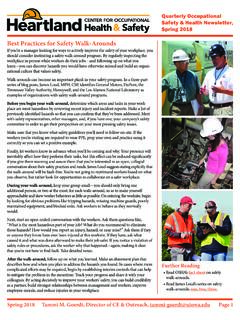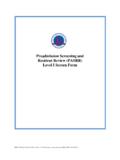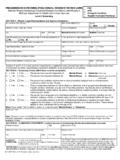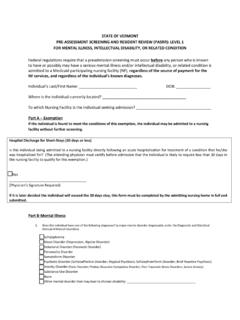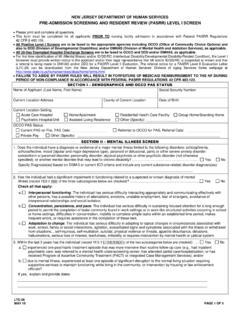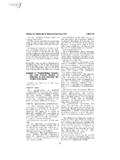Transcription of Federal PASRR Regulations Title 42 of the Code of …
1 Code of Federal Regulations : PASRR 42 CFR 483 Subpart C 1 Federal PASRR Regulations Title 42 of the Code of Federal Regulations (CFR) contains Medicaid rules. Citations are written as 42 CFR . Access the CFR at When searching the CFR, keep in mind that the Regulations at (c) have not been amended to reflect the statutory change dropping the annual resident review requirement. This is why the CFR refers to Preadmission Screening and Annual Resident Review and PASARR . Therefore, search PASARR rather than PASRR . Also, search will be more accurate with preadmission screening and annual as the succeeding words in some instances are review and in others resident review . This document first presents 42 CFR through 138, the main body of PASRR regulation.
2 Following, on page 19, are other references to PASARR in the CFR. Title 42 -- PUBLIC HEALTH CHAPTER IV -- CENTERS FOR MEDICARE & MEDICAID SERVICES, DEPARTMENT OF HEALTH AND HUMAN SERVICES SUBCHAPTER G -- STANDARDS AND CERTIFICATION PART 483 -- REQUIREMENTS FOR STATES AND LONG TERM CARE FACILITIES SUBPART C -- PREADMISSION SCREENING AND ANNUAL REVIEW OF MENTALLY ILL AND MENTALLY RETARDED INDIVIDUALS Basis. The requirements of through governing the State's responsibility for preadmission screening and annual resident review (PASARR) of individuals with mental illness and mental retardation are based on section 1919(e)(7) of the Act. Applicability and definitions.
3 (a) This subpart applies to the screening or reviewing of all individuals with mental illness or mental retardation who apply to or reside in Medicaid certified NFs regardless of the source of payment for the NF services, and regardless of the individual's or resident's known diagnoses. (b) Definitions. As used in this subpart-- (1) An individual is considered to have a serious mental illness (MI) if the individual meets the following requirements on diagnosis, level of impairment and duration of illness: (i) Diagnosis. The individual has a major mental disorder diagnosable under the Diagnostic and Statistical Manual of Mental Disorders, 3rd edition, revised in 1987. Code of Federal Regulations : PASRR 42 CFR 483 Subpart C 2 Incorporation of the 1987 edition of the Diagnostic and Statistical Manual of Mental Disorders, 3rd edition, was approved by the Director of the Federal Register in accordance with 5 552(a) and 1 CFR part 51 that govern the use of incorporation by reference.
4 The Diagnostic and Statistical Manual of Mental Disorders is available for inspection at the Centers for Medicare & Medicaid Services, room 132, East High Rise Building, 6325 Security Boulevard, Baltimore, Maryland, or at the Office of the Federal Register, suite 700, 800 North Capitol St. NW., Washington, DC. Copies may be obtained from the American Psychiatric Association, Division of Publications and Marketing, 1400 K Street, NW., Washington, DC 20005. This mental disorder is-- (A) A schizophrenic, mood, paranoid, panic or other severe anxiety disorder; somatoform disorder; personality disorder; other psychotic disorder; or another mental disorder that may lead to a chronic disability; but (B) Not a primary diagnosis of dementia, including Alzheimer's disease or a related disorder, or a non-primary diagnosis of dementia unless the primary diagnosis is a major mental disorder as defined in paragraph (b)(1)(i)(A) of this section.
5 (ii) Level of impairment. The disorder results in functional limitations in major life activities within the past 3 to 6 months that would be appropriate for the individual's developmental stage. An individual typically has at least one of the following characteristics on a continuing or intermittent basis: (A) Interpersonal functioning. The individual has serious difficulty interacting appropriately and communicating effectively with other persons, has a possible history of altercations, evictions, firing, fear of strangers, avoidance of interpersonal relationships and social isolation; (B) Concentration, persistence, and pace. The individual has serious difficulty in sustaining focused attention for a long enough period to permit the completion of tasks commonly found in work settings or in work-like structured activities occurring in school or home settings, manifests difficulties in concentration, inability to complete simple tasks within an established time period, makes frequent errors, or requires assistance in the completion of these tasks; and (C) Adaptation to change.
6 The individual has serious difficulty in adapting to typical changes in circumstances associated with work, school, family, or social interaction, manifests agitation, exacerbated signs and symptoms associated with the illness, or withdrawal from the situation, or requires intervention by the mental health or judicial system. (iii) Recent treatment. The treatment history indicates that the individual has experienced at least one of the following: (A) Psychiatric treatment more intensive than outpatient care more than once in the past 2 years ( , partial hospitalization or inpatient hospitalization); or (B) Within the last 2 years, due to the mental disorder, experienced an episode of significant disruption to the normal living situation, for which supportive services were required to maintain functioning at home, or in a residential treatment environment, or which resulted in intervention by housing or law enforcement officials.
7 (2) An individual is considered to have dementia if he or she has a primary diagnosis of dementia, as described in the Diagnostic and Statistical Manual of Mental Disorders, 3rd edition, Code of Federal Regulations : PASRR 42 CFR 483 Subpart C 3 revised in 1987, or a non-primary diagnosis of dementia unless the primary diagnosis is a major mental disorder as defined in paragraph (b)(1)(i)(A) of this section. (3) An individual is considered to have mental retardation (MR) if he or she has-- (i) A level of retardation (mild, moderate, severe or profound) described in the American Association on Mental Retardation's Manual on Classification in Mental Retardation (1983). Incorporation by reference of the 1983 edition of the American Association on Mental Retardation's Manual on Classification in Mental Retardation was approved by the Director of the Federal Register in accordance with 5 552(a) and 1 CFR part 51 that govern the use of incorporations by reference; The American Association on Mental Retardation's Manual on Classification in Mental Retardation is available for inspection at the Centers for Medicare & Medicaid Services, Room 132, East High Rise Building, 6325 Security Boulevard, Baltimore, Maryland, or at the Office of the Federal Register Information Center, Suite 700, 800 North Capitol St.
8 NW., Washington, DC. Copies may be obtained from the American Association on Mental Retardation, 1719 Kalorama Rd., NW., Washington, DC 20009. (ii) A related condition as defined by of this chapter. State plan requirement. As a condition of approval of the State plan, the State must operate a preadmission screening and annual resident review program that meets the requirements of through Basic rule. (a) Requirement. The State PASARR program must require--(1) Preadmission screening of all individuals with mental illness or mental retardation who apply as new admissions to Medicaid NFs on or after January 1, 1989; (2) Initial review, by April 1, 1990, of all current residents with mental retardation or mental illness who entered Medicaid NFs prior to January 1, 1989; and (3) At least annual review, as of April 1, 1990, of all residents with mental illness or mental retardation, regardless of whether they were first screened under the preadmission screening or annual resident review requirements.
9 (b) Admissions, readmissions and interfacility (1) New admission. An individual is a new admission if he or she is admitted to any NF for the first time or does not qualify as a readmission. With the exception of certain hospital discharges described in paragraph (b)(2) of this section, new admissions are subject to preadmission screening. (2) Exempted hospital discharge. (i) An exempted hospital discharge means an individual-- (A) Who is admitted to any NF directly from a hospital after receiving acute inpatient care at the hospital; (B) Who requires NF services for the condition for which he or she received care in the hospital; and (C) Whose attending physician has certified before admission to the facility that the individual is likely to require less than 30 days nursing facility services.
10 Code of Federal Regulations : PASRR 42 CFR 483 Subpart C 4 (ii) If an individual who enters a NF as an exempted hospital discharge is later found to require more than 30 days of NF care, the State mental health or mental retardation authority must conduct an annual resident review within 40 calendar days of admission. (3) Readmissions. An individual is a readmission if he or she was readmitted to a facility from a hospital to which he or she was transferred for the purpose of receiving care. Readmissions are subject to annual resident review rather than preadmission screening. (4) Interfacility (i) An interfacility transfer occurs when an individual is transferred from one NF to another NF, with or without an intervening hospital stay.


